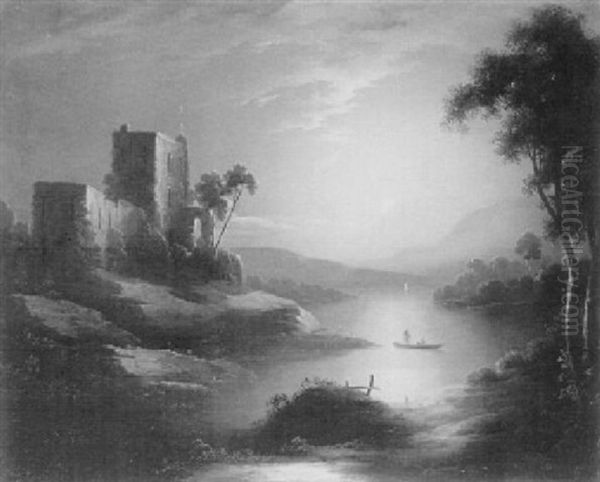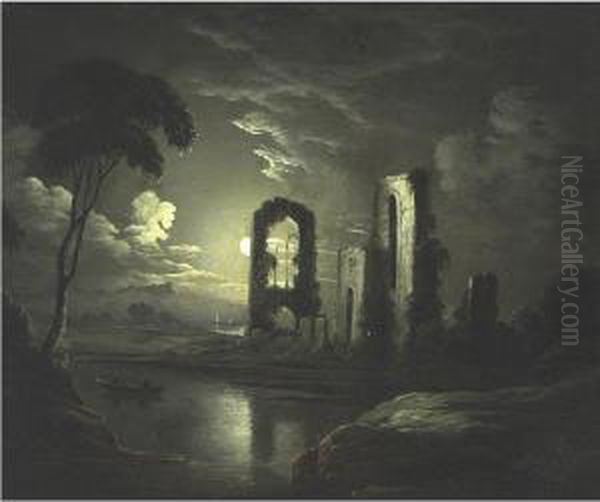Sebastian Pether stands as a significant, albeit often overlooked, figure in the rich tapestry of British landscape painting. Active during the height of the Romantic era, Pether carved a distinct niche for himself, becoming renowned for his evocative and atmospheric depictions of nocturnal scenes, particularly those bathed in the ethereal glow of moonlight or the dramatic flare of firelight. Born into an artistic dynasty, he carried forward a family tradition while developing his own unique sensibility, leaving behind a body of work that captures the mystery, beauty, and sometimes the terror, of the night.
Early Life and Artistic Lineage
Born in England around 1790, Sebastian Pether was immersed in the world of art from his earliest days. He was the eldest son of Abraham Pether (1756–1812), a highly respected and versatile artist often referred to as "Old Pether." Abraham was not only a painter known for his own moonlit landscapes, which undoubtedly served as the primary inspiration for his sons, but also a talented musician and inventor. This creative household environment provided a fertile ground for Sebastian's burgeoning artistic talents.
The Pether family became synonymous with a particular type of landscape painting, earning the collective moniker the "Moonlight Pethers." Sebastian, along with his younger brother Henry Pether (fl. 1828–1865), followed directly in their father's footsteps, specializing in nocturnal views. While both brothers achieved recognition for their moonlit scenes, Sebastian is often considered the most accomplished of the siblings in this specific genre, demonstrating a particular finesse in capturing the subtle gradations of light and shadow inherent in nighttime settings. His early training likely came directly from his father, absorbing the techniques and thematic preoccupations that would define his career.
The Art of the Nocturne: Style and Technique
Sebastian Pether's artistic identity is inextricably linked to the nocturne. He possessed a remarkable ability to render the effects of moonlight on water, architecture, and foliage. His style is characterized by a careful, almost meticulous, attention to detail, combined with a strong sense of atmosphere and mood. Unlike the broader, more turbulent brushwork of contemporaries like J.M.W. Turner, Pether's approach often involved smoother surfaces and a more precise delineation of forms, even when shrouded in darkness.

His handling of light was paramount. Whether depicting the cool, silvery cast of the moon or the warm, intense glow of a fire, Pether masterfully contrasted light sources against deep shadows to create dramatic and visually compelling compositions. His skies are often studies in subtle tonal variation, capturing the specific quality of light associated with different times of night or weather conditions. There's a quietude and stillness in many of his moonlit river scenes and landscapes, evoking the serene yet mysterious quality of the nocturnal world.
Pether's work can be seen as part of a broader European tradition of nocturne painting, stretching back to artists like the Dutch Golden Age painter Aert van der Neer, who specialized in moonlit and winter landscapes. In Britain, Joseph Wright of Derby had earlier explored the dramatic effects of artificial light and moonlight in his industrial scenes and scientific subjects, paving the way for the Romantic fascination with varied light conditions. Pether, however, focused primarily on the natural landscape illuminated by the moon or, occasionally, by fire.
Signature Themes: Moonlit Landscapes
Moonlight was Pether's most recurrent and defining theme. He frequently depicted tranquil river scenes, often featuring boats gliding silently on the water, their reflections shimmering under the moon. Castles, abbeys, and churches, particularly those in ruins, were also favourite subjects. These architectural elements, bathed in moonlight, tapped directly into the Romantic sensibility, evoking feelings of nostalgia, melancholy, and the passage of time. The interest in Gothic architecture and ruins was a hallmark of the era, explored by artists such as Thomas Girtin and the early Turner.
One notable example showcasing this theme is A Ruined Gothic Church by the River under Moonlight. Such works demonstrate Pether's skill in rendering architectural detail while simultaneously imbuing the scene with a powerful sense of atmosphere. The interplay between the solid forms of the ruins and the ephemeral quality of the moonlight creates a poignant visual poetry. His landscapes often feel carefully composed, balancing the elements to achieve a harmonious, albeit sometimes somber, effect. While perhaps lacking the visionary intensity of Samuel Palmer's mystical moonlit scenes, Pether's work possesses a distinct charm and technical proficiency in its chosen domain.
Signature Themes: The Spectacle of Vesuvius
Beyond the tranquil moonlit scenes, Sebastian Pether also tackled more dramatic and sublime subjects, most notably the eruption of Mount Vesuvius. His painting The Eruption of Vesuvius is one of his most recognized works. This subject held a powerful fascination for Romantic artists and audiences, fueled by the rediscovery of Pompeii and Herculaneum in the 18th century and the popularity of the Grand Tour, which often included a visit to Naples and its famous volcano.

Pether's depiction captures the terrifying grandeur of the eruption, contrasting the fiery lava flows and smoke plumes against the dark night sky, often illuminated by a full moon. This juxtaposition of natural light sources – the cool moon and the hot volcano – creates a powerful visual drama. Some accounts suggest Pether may have travelled to Italy, possibly Naples, to witness the volcano or gather inspiration, although concrete evidence for such a trip remains elusive. Regardless, his paintings of Vesuvius effectively convey the Romantic concept of the Sublime – the feeling of awe mixed with terror experienced in the face of nature's overwhelming power.
Other artists of the period also famously depicted Vesuvius, including Joseph Wright of Derby, the French painter Pierre-Jacques Volaire (who specialized in the subject), and even J.M.W. Turner. Pether's interpretations stand out for their characteristic handling of light and atmosphere, fitting within his broader oeuvre of nocturnal and dramatic light effects. These works share a certain affinity with the apocalyptic visions of another contemporary, John Martin, known for his vast canvases depicting biblical catastrophes and dramatic natural phenomena.
Career Challenges and Recognition
Despite his evident talent and specialization in a popular genre, Sebastian Pether's professional career was marked by significant challenges. While his works found a market, often sold through art dealers rather than direct patronage, the income generated appears to have been insufficient to support his large family. He married young and reportedly had nine children, placing considerable financial strain on him throughout his life.
Furthermore, Pether struggled to gain official recognition from the established art institutions of the day. He submitted works to the prestigious Royal Academy of Arts for exhibition on several occasions, but records indicate his submissions were rejected at least three times. This lack of access to the RA's influential platform would have limited his exposure to potential patrons and hindered his ability to command higher prices for his work. In the highly competitive London art world, success often depended on connections and institutional validation, pathways seemingly closed to Pether. This contrasts sharply with the careers of highly successful contemporaries like Sir Thomas Lawrence, J.M.W. Turner, and John Constable, who navigated the RA system effectively. Consequently, despite his artistic output, Sebastian Pether faced considerable hardship and ultimately died in poverty in Battersea on 14 March 1844.
Interactions and Context
Specific records detailing Sebastian Pether's interactions with other prominent artists outside his own family are scarce. The provided information explicitly notes a lack of documented evidence regarding collaborations or membership in formal artistic groups or societies. His primary artistic circle seems to have been his immediate family – his father Abraham and his brother Henry. They shared thematic interests and likely techniques, forming a distinct familial school of painting focused on moonlight effects.
However, Pether worked within the bustling artistic milieu of London during the first half of the 19th century. He would have been aware of, and likely seen the work of, the major figures of British Romantic landscape painting. Artists like Turner and Constable were transforming the genre, while others such as John Linnell and David Cox were also producing significant landscape works. While direct influence or interaction is not documented, Pether's art inevitably existed in dialogue with the prevailing artistic trends and tastes of his time, particularly the Romantic fascination with nature, atmosphere, and dramatic light. His father, Abraham, being a more established figure, likely had wider connections within the art world which Sebastian might have tangentially benefited from, but Sebastian himself appears to have remained somewhat on the periphery.
Legacy and Influence
Sebastian Pether's legacy resides primarily in his contribution to the genre of the nocturne within British Romanticism. As a key member of the "Moonlight Pether" family, he helped popularize and refine the depiction of moonlit scenes, demonstrating considerable technical skill and atmospheric sensitivity. While his father initiated the family tradition, Sebastian is often credited with bringing a particular delicacy and refinement to the subject, arguably surpassing his siblings in this specific area.
Though perhaps not a major innovator on the scale of Turner or Constable, Pether's work had a discernible influence. His focus on atmospheric night scenes, particularly those with moonlight, is seen as a precursor to the later Victorian fascination with nocturnes. Most notably, his work is considered an important influence on the Leeds-based artist John Atkinson Grimshaw (1836-1893), who became famous for his own evocative moonlit urban and dockland scenes, often imbued with a similar sense of quiet mystery and detailed rendering. Grimshaw's "moonlights" owe a clear debt to the tradition established by the Pether family.
Even later artists, such as James Abbott McNeill Whistler, who famously titled his atmospheric paintings "Nocturnes," built upon the foundations laid by earlier painters like Pether who explored the aesthetic possibilities of the night. Sebastian Pether's paintings continue to be appreciated today and are held in various public and private collections. His dramatic depictions of Vesuvius, in particular, occasionally feature in exhibitions exploring the art of the Grand Tour or the representation of natural disasters, reminding contemporary audiences of his skill in capturing the sublime power of nature.
Conclusion
Sebastian Pether remains a compelling figure in British art history, a specialist who dedicated his career to capturing the elusive beauty and drama of the night. Born into an artistic family, he mastered the depiction of moonlight, creating serene and atmospheric landscapes that resonated with the Romantic spirit of his age. He also tackled grander, more terrifying themes, such as the eruption of Vesuvius, showcasing his versatility in handling different effects of light and shadow. Despite facing significant personal and professional challenges, including financial hardship and rejection by the Royal Academy, Pether produced a consistent body of work characterized by technical skill and evocative mood. His paintings, particularly his moonlit scenes, secured his place within the Pether dynasty and influenced subsequent generations of artists drawn to the poetics of the nocturne. He stands as a testament to the dedicated artist pursuing a singular vision, leaving behind a legacy illuminated by the soft glow of the moon.